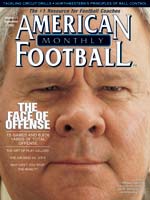AMERICAN FOOTBALL MONTHLY THE #1 RESOURCE FOR FOOTBALL COACHES
Article CategoriesAFM Magazine
|
The Art of Play CallingWhat goes into an Offensive Coordinatorís game plan?by: W. Keith Roerdink © More from this issue A good play is easy to spot on game day. Itís the decision to go for it on fourth-and-one that yields a fresh set of downs, a blitz-beating touchdown toss, or even a basic trap play, executed perfectly a handful of times, that marches your offense down the field. But while these plays unfold in the moment, itís the weeks and even months of preparation that ultimately make them work. Good play calling is the result of repetition and trial and error without the glare of the lights or the eyes of the crowd. Itís the tweaking and the teaching and the implementation of concepts that were rolled out in spring practices or honed on hot summer days. For some, itís a near exact science. For others, itís an innate feel when they are in the flow of the game. And for others still, itís a bit of both. Play calling can be as unique as....The full article can only be seen by subscribers. Subscribe today!
|
|
|||||||
| HOME |
MAGAZINE |
SUBSCRIBE | ONLINE COLUMNISTS | COACHING VIDEOS |
Copyright 2025, AmericanFootballMonthly.com
All Rights Reserved





